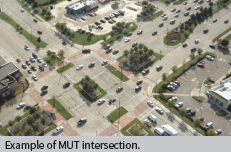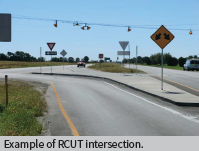U.S. Department of Transportation
Federal Highway Administration
1200 New Jersey Avenue, SE
Washington, DC 20590
202-366-4000

Source: FHWA
SAFETY BENEFITS:
RCUT
54%
Reduction in injury and fatal crashes1
MUT
30%
Reduction in intersection-related injury crash rate2
1 Edara et al., "Evaluation of J-turn Intersection Design Performance in Missouri," December 2013.
2 FHWA, Median U-Turn Intersection Informational Guide, FHWA-SA-14-069 (Washington, DC: 2014), pp. 41-42.
Reduced left-turn conflict intersections are geometric designs that alter how left-turn movements occur in order to simplify decisions and minimize the potential for related crashes. Two highly effective designs that rely on U-turns to complete certain left-turn movements are known as the restricted crossing U-turn (RCUT) and the median U-turn (MUT).

The RCUT intersection modifies the direct left-turn and through movements from cross-street approaches. Minor road traffic makes a right turn followed by a U-turn at a designated location – either signalized or unsignalized – to continue in the desired direction.
The RCUT is suitable for a variety of circumstances, including along rural, high-speed, four-lane, divided highways or signalized routes. It also can be used as an alternative to signalization or constructing an interchange. RCUTs work well when consistently used along a corridor, but also can be used effectively at individual intersections.
The MUT intersection modifies direct left turns from the major approaches. Vehicles proceed through the main intersection, make a U-turn a short distance downstream, followed by a right turn at the main intersection. The U-turns can also be used for modifying the cross-street left turns.
The MUT is an excellent choice for heavily traveled intersections with moderate left-turn volumes. When implemented at multiple intersections along a corridor, the efficient two-phase signal operation of the MUT can reduce delay, improve travel times, and create more crossing opportunities for pedestrians and bicyclists.

Source: FHWA

